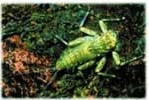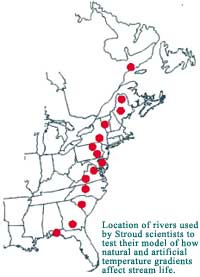Thermal Equilibrium Concept

Beginning in the 1950s, both scientists and the general public had begun to grow increasingly concerned about the effects of thermal pollution in streams and rivers. Researchers documented critical changes — and in many cases the extinction of entire species — in plant and animal communities in streams that experienced significant shifts in temperature patterns.
Such stress occurred in a wide variety of areas: in streams below power plants, industrial operations and top-release dams that discharged warm water; in streams below bottom-release dams and refrigeration facilities that discharged cold water; in streams whose channels had been dredged and in those whose watersheds had been deforested.
Initial laboratory experiments focused on the tolerances of individual species. By progressively increasing or decreasing temperatures, researchers discovered upper and lower thermal limits. When these were exceeded, over half the test organisms died. In the field, however, scientists found that the correlation between survivorship and water temperature was more complicated than the limits established in the laboratory.
In 1972 Bern Sweeney and Robin Vannote took a different tack. Abandoning the idea of thermal limits, they hypothesized that temperature changes altered the normal characteristics and growth cycle of a species, which in turn reduced its adult size and reproductive activity.
Instead of occurring catastrophically when a lethal limit had been exceeded, extinction happened gradually over several generations — in response to factors that were not in themselves lethal. Sweeney and Vannote further proposed that the sensitivity of a species to temperature change also had a geographic component.

Between 1980 and 1985 these ideas were put to a rigorous test on 25 river systems that stretched across the eastern Piedmont region of North America from Florida to Quebec. This remains the largest project ever undertaken at the Stroud Water Research Center, and its results confirmed the essential tenets of both hypotheses.
For example, because a species near the southern limit of its range would already be stressed by the heat, it would be more vulnerable to rising water temperatures than if it were further north. After four years of experiments, Sweeney and Vannote published their results in Science (1978) and The American Naturalist (1980). Their Thermal Equilibrium Concept proposed two hypotheses:
- that for many cold-blooded aquatic animals, especially insects, a direct correlation exists between water temperature and reproductive potential;
- that changing temperature cycles affect the geographic distribution of a species by gradually lowering its reproductive vitality.
While many species evolve elaborate genetic mechanisms to cope with severe seasonal changes in temperature, such adaptations offer little protection against human activities. In a world increasingly intent on protecting its water, the Thermal Equilibrium Model provided a quantifiable way to measure the impact of pollution on stream life.
